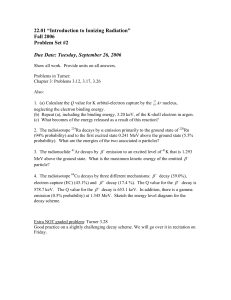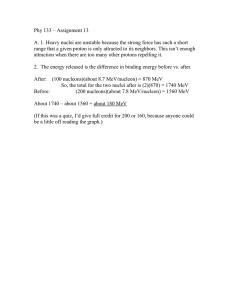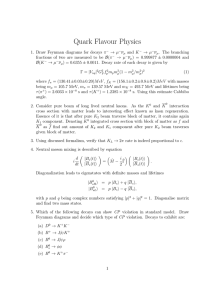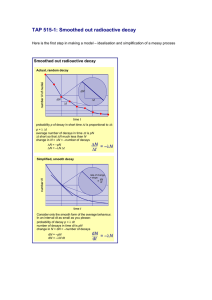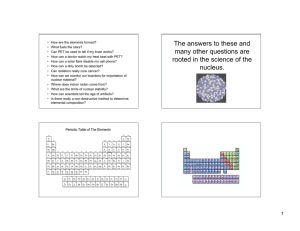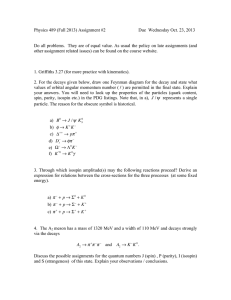Suggested Problem Solutions Associated with Homework #5
advertisement
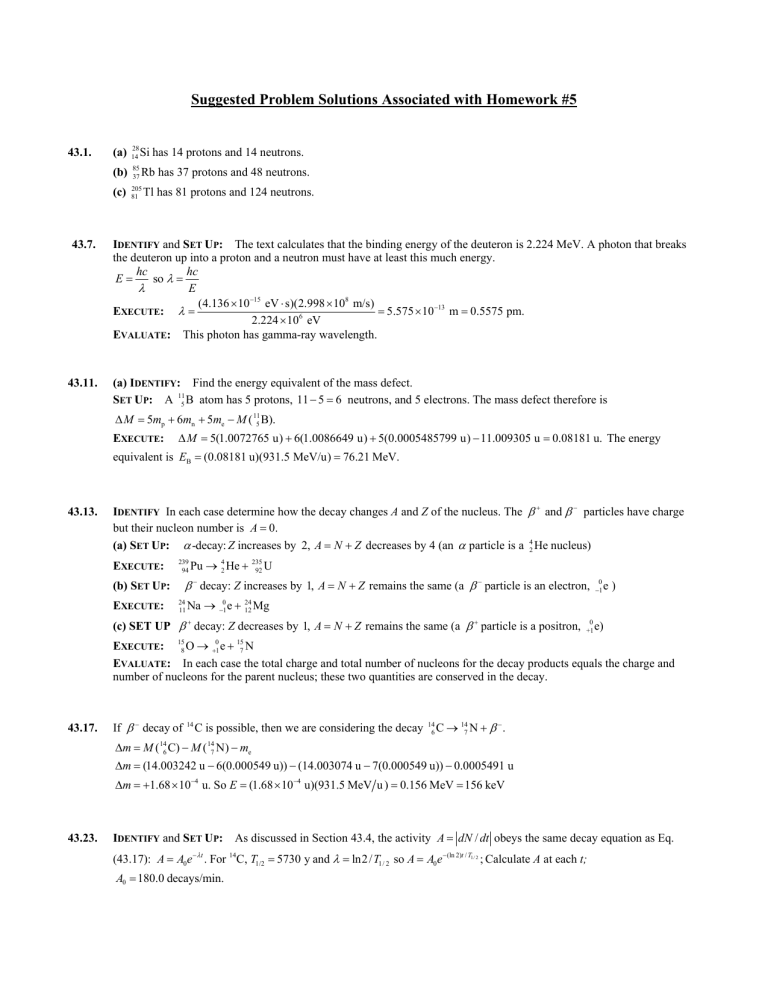
Suggested Problem Solutions Associated with Homework #5 43.1. 43.7. 43.11. (a) 28 14 Si has 14 protons and 14 neutrons. (b) 85 37 Rb has 37 protons and 48 neutrons. (c) 205 81 Tl has 81 protons and 124 neutrons. IDENTIFY and SET UP: The text calculates that the binding energy of the deuteron is 2.224 MeV. A photon that breaks the deuteron up into a proton and a neutron must have at least this much energy. hc hc E= so λ = λ E (4.136 × 10 −15 eV ⋅ s)(2.998 × 108 m/s) = 5.575 × 10−13 m = 0.5575 pm. EXECUTE: λ = 2.224 × 106 eV EVALUATE: This photon has gamma-ray wavelength. (a) IDENTIFY: Find the energy equivalent of the mass defect. SET UP: A 115 B atom has 5 protons, 11 − 5 = 6 neutrons, and 5 electrons. The mass defect therefore is ∆ M = 5mp + 6mn + 5me − M ( 115 B). EXECUTE: ∆ M = 5(1.0072765 u) + 6(1.0086649 u) + 5(0.0005485799 u) − 11.009305 u = 0.08181 u. The energy equivalent is EB = (0.08181 u)(931.5 MeV/u) = 76.21 MeV. 43.13. IDENTIFY In each case determine how the decay changes A and Z of the nucleus. The β + and β − particles have charge but their nucleon number is A = 0. (a) SET UP: α -decay: Z increases by 2, A = N + Z decreases by 4 (an α particle is a 42 He nucleus) EXECUTE: 239 94 β − decay: Z increases by 1, A = N + Z remains the same (a β − particle is an electron, (b) SET UP: EXECUTE: Pu → 42 He + 235 92 U 24 11 0 −1 e) Na → e + Mg 0 −1 24 12 (c) SET UP β + decay: Z decreases by 1, A = N + Z remains the same (a β + particle is a positron, 0 +1 e) EXECUTE: O→ e+ N EVALUATE: In each case the total charge and total number of nucleons for the decay products equals the charge and number of nucleons for the parent nucleus; these two quantities are conserved in the decay. 15 8 43.17. If β − decay of 0 +1 14 15 7 C is possible, then we are considering the decay 14 6 C → 147 N + β − . ∆m = M ( 146 C) − M ( 147 N) − me ∆m = (14.003242 u − 6(0.000549 u)) − (14.003074 u − 7(0.000549 u)) − 0.0005491 u ∆m = +1.68 × 10−4 u. So E = (1.68 × 10−4 u)(931.5 MeV u ) = 0.156 MeV = 156 keV 43.23. IDENTIFY and SET UP: −λt As discussed in Section 43.4, the activity A = dN / dt obeys the same decay equation as Eq. (43.17): A = A0e . For C, T1/2 = 5730 y and λ = ln2 / T1/ 2 so A = A0e − (ln 2)t / T1/ 2 ; Calculate A at each t; A0 = 180.0 decays/min. 14 EXECUTE: (a) t = 1000 y, A = 159 decays/min (b) t = 50,000 y, A = 0.43 decays/min EVALUATE: 43.25. The time in part (b) is 8.73 half-lives, so the decay rate has decreased by a factor or ( 12 )8.73 . (a) 31 H → −01 e + 23 He (b) N = N 0e− λt , N = 0.100 N 0 and λ = (ln 2) T1 0.100 = e 43.27. A = A0e − λ t = A0e T1 2 = − 43.31. (a) − t (ln 2) / T1 / 2 . − − t (ln 2) T1 2 2 ; −t (ln 2) T1 2 = ln(0.100); t = − ln(0.100)T1 2 ln 2 = 40.9 y (ln 2)t = ln( A A0 ) . T1 2 (ln 2)t (ln 2)(4.00 days) =− = 2.80 days ln( A A0 ) ln(3091 8318) 0.693 0.693 dN = = 3.75 × 10−4 s −1. = 7.56 × 1011 Bq = 7.56 × 1011 decays s . λ = T1 2 (30.8 min)(60 s min) dt N0 = 1 dN 7.56 × 1011 decays s = = 2.02 × 1015 nuclei. 3.75 × 10−4 s −1 λ dt (b) The number of nuclei left after one half-life is N0 = 1.01 × 1015 nuclei, and the activity is half: 2 dN = 3.78 × 1011 decays s. dt (c) After three half lives (92.4 minutes) there is an eighth of the original amount, so N = 2.53 × 1014 nuclei, and an eighth dN 10 of the activity: = 9.45 × 10 decays s . dt 43.33. IDENTIFY and SET UP: Find λ from the half-life and the number N of nuclei from the mass of one nucleus and the mass of the sample. Then use Eq.(43.16) to calculate | dN / dt |, the number of decays per second. EXECUTE: (a) | dN / dt |= λ N 0.693 0.693 λ= = = 1.715 × 10−17 s −1 T1/ 2 (1.28 × 109 y)(3.156 × 107 s/1 y) The mass of 40 K atom is approximately 40 u, so the number of 1.63 × 10−9 kg 1.63 × 10−9 kg N= = = 2.454 × 1016. 40 u 40(1.66054 × 10−27 kg) 40 K nuclei in the sample is Then | dN / dt |= λ N = (1.715 × 10−17 s −1 )(2.454 × 1016 ) = 0.421 decays/s (b) | dN / dt |= (0.421 decays/s)(1 Ci/(3.70 × 1010 decays/s)) = 1.14 × 10−11 Ci EVALUATE: The very small sample still contains a very large number of nuclei. But the half life is very large, so the decay rate is small. Suggested Problem Solutions Associated with Homework #6 43.35. 1 rad = 10−2 Gy, so 1 Gy = 100 rad and the dose was 500 rad. rem = (rad)(RBE) = (500 rad)(4.0) = 2000 rem. 1 Gy = 1 J kg , so 5.0 J kg . 43.37. IDENTIFY and SET UP: For x rays RBE = 1 and the equivalent dose equals the absorbed dose. EXECUTE: (a) 175 krad = 175 krem = 1.75 kGy = 1.75 kSv (1.75 × 103 J/kg)(0.150 kg) = 2.62 × 102 J (b) 175 krad = 1.75 kGy ; (1.50)(175 krad) = 262 krem = 2.62 kSv The energy deposited would be 2.62 × 102 J , the same as in (a). EVALUATE: The energy required to raise the temperature of 0.150 kg of water 1 C° is 628 J, and 2.62 × 102 J is less than this. The energy deposited corresponds to a very small amount of heating. 43.39. (a) We need to know how many decays per second occur. λ= 0.693 0.693 = = 1.79 × 10−9 s −1. T1 2 (12.3 y) (3.156 × 107 s y) 1 dN (0.35 Ci) (3.70 × 1010 Bq Ci ) = = 7.2540 × 1018 nuclei . λ dt 1.79 × 10−9 s −1 The number of remaining nuclei after one week is −9 −1 N = N 0e − λ t = (7.25 × 1018 )e− (1.79 ×10 s ) (7) (24) (3600s) = 7.2462 × 1018 nuclei. ∆ N = N 0 − N = 7.8 × 1015 decays. So the energy The number of tritium atoms is N 0 = absorbed is Etotal = ∆ N Eγ = (7.8 × 1015 ) (5000 eV) (1.60 × 10−19 J eV ) = 6.24 J. The absorbed dose is (6.24 J) = 0.125 J kg = 12.5 rad. Since RBE = 1, then the equivalent dose is 12.5 rem. (50 kg) (b) In the decay, antinetrinos are also emitted. These are not absorbed by the body, and so some of the energy of the decay is lost (about 12 keV ). 43.41. (a) IDENTIFY and SET UP: Determine X by balancing the charge and nucleon number on the two sides of the reaction equation. EXECUTE: X must have A = 2 + 14 − 10 = 6 and Z = 1 + 7 − 5 = 3. Thus X is 63 Li and the reaction is H + 147 N → 63 Li + 105 B (b) IDENTIFY and SET UP: Calculate the mass decrease and find its energy equivalent. EXECUTE: The neutral atoms on each side of the reaction equation have a total of 8 electrons, so the electron masses cancel when neutral atom masses are used. The neutral atom masses are found in Table 43.2. mass of 21 H + 147 N is 2.014102 u + 14.003074 u = 16.017176 u 2 1 mass of 63 Li + 105 B is 6.015121 u + 10.012937 u = 16.028058 u The mass increases, so energy is absorbed by the reaction. The Q value is (16.017176 u − 16.028058 u)(931.5 MeV/u) = −10.14 MeV (c) IDENTIFY and SET UP: The available energy in the collision, the kinetic energy K cm in the center of mass reference frame, is related to the kinetic energy K of the bombarding particle by Eq. (43.24). EXECUTE: The kinetic energy that must be available to cause the reaction is 10.14 MeV. Thus K cm = 10.14 MeV. The mass M of the stationary target ( 147 N) is M = 14 u. The mass m of the colliding particle ( 21 H) is 2 u. Then by Eq. (43.24) the minimum kinetic energy K that the 21 H must have is M +m 14 u + 2 u K = K cm = (10.14 MeV) = 11.59 MeV M 14 u EVALUATE: The projectile ( H ) is much lighter than the target ( 2 1 14 7 N ) so K is not much larger than K cm . The K we have calculated is what is required to allow the mass increase. We would also need to check to see if at this energy the projectile can overcome the Coulomb repulsion to get sufficiently close to the target nucleus for the reaction to occur. 43.43. IDENTIFY and SET UP: Determine X by balancing the charge and the nucleon number on the two sides of the reaction equation. EXECUTE: X must have A = +2 + 9 − 4 = 7 and Z = +1 + 4 − 2 = 3. Thus X is 37 Li and the reaction is 12 H + 94Be = 37 Li + 42 He (b) IDENTIFY and SET UP: Calculate the mass decrease and find its energy equivalent. EXECUTE: If we use the neutral atom masses then there are the same number of electrons (five) in the reactants as in the products. Their masses cancel, so we get the same mass defect whether we use nuclear masses or neutral atom masses. The neutral atoms masses are given in Table 43.2. 2 9 1 H + 4 Be has mass 2.014102 u + 9.012182 u = 11.26284 u Li + 24 He has mass 7.016003 u + 4.002603 u = 11.018606 u The mass decrease is 11.026284 u − 11.018606 u = 0.007678 u. This corresponds to an energy release of 0.007678 u(931.5 MeV/1 u) = 7.152 MeV. (c) IDENTIFY and SET UP: Estimate the threshold energy by calculating the Coulomb potential energy when the 2 9 1 H and 4 Be nuclei just touch. Obtain the nuclear radii from Eq. (43.1). 7 3 EXECUTE: The radius RBe of the 94 Be nucleus is RBe = (1.2 × 10−15 m)(9)1/3 = 2.5 × 10−15 m. The radius RH of the 12H nucleus is RH = (1.2 × 10−15 m)(2)1/3 = 1.5 × 10−15 m. The nuclei touch when their center-to-center separation is R = RBe + RH = 4.0 × 10−15 m. The Coulomb potential energy of the two reactant nuclei at this separation is 1 q1q2 1 e(4e) = U= 4π P0 r 4π P0 r 4(1.602 × 10−19 C) 2 = 1.4 MeV (4.0 × 10−15 m)(1.602 × 10−19 J/eV) This is an estimate of the threshold energy for this reaction. EVALUATE: The reaction releases energy but the total initial kinetic energy of the reactants must be 1.4 MeV in order for the reacting nuclei to get close enough to each other for the reaction to occur. The nuclear force is strong but is very shortrange. U = (8.988 × 109 N ⋅ m 2 / C 2 ) 43.47. The energy liberated will be M (32 He) + M ( 24 He) − M (74 Be) = (3.016029 u + 4.002603 u − 7.016929 u)(931.5 MeV u) = 1.586 MeV. 43.59. IDENTIFY and SET UP: Find the energy equivalent of the mass decrease. Part of the released energy appears as the emitted photon and the rest as kinetic energy of the electron. 198 0 EXECUTE: 198 79 Au → 80 Hg + −1 e The mass change is 197.968225 u − 197.966752 u = 1.473 × 10−3 u (The neutral atom masses include 79 electrons before the decay and 80 electrons after the decay. This one additional electron in the products accounts correctly for the electron emitted by the nucleus.) The total energy released in the decay is (1.473 × 10−3 u)(931.5 MeV/u) = 1.372 MeV. This energy is divided between the energy of the emitted photon and the kinetic energy of the β − particle. Thus the β − particle has kinetic energy equal to 1.372 MeV − 0.412 MeV = 0.960 MeV. The emitted electron is much lighter than the EVALUATE: energy. The final kinetic energy of the 43.67. IDENTIFY: SET UP: 198 198 80 Hg nucleus, so the electron has almost all the final kinetic Hg nucleus is very small. Use Eq. (43.17) to relate the initial number of radioactive nuclei, N 0 , to the number , N, left after time t. We have to be careful; after the number of 85 87 Rb has undergone radioactive decay it is no longer a rubidium atom. Let N85 be Rb atoms; this number doesn’t change. Let N 0 be the number of 87 Rb atoms on earth when the solar 87 system was formed. Let N be the present number of Rb atoms. EXECUTE: The present measurements say that 0.2783 = N /( N + N85 ). ( N + N85 )(0.2783) = N , so N = 0.3856 N85 . The percentage we are asked to calculate is N 0 /( N 0 + N85 ). N and N 0 are related by N = N 0e− λ t so N 0 = e+ λt N . Thus N0 Neλ t (0.3855eλ t ) N85 0.3856eλt . = λt = = λt N 0 + N85 Ne + N85 (0.3856e ) N85 + N85 0.3856eλt + 1 t = 4.6 × 109 y; λ = −11 −1 0.693 0.693 = = 1.459 × 10−11 y −1 4.75 × 1010 y T1/2 9 eλt = e(1.459×10 y )(4.6×10 y) = e0.16711 = 1.0694 N0 (0.3856)(1.0694) Thus = = 29.2%. N 0 + N85 (0.3856)(1.0694) + 1 EVALUATE: The half-life for 87 Rb is a factor of 10 larger than the age of the solar system, so only a small fraction of the 87 Rb nuclei initially present have decayed; the percentage of rubidium atoms that are radioactive is only a bit less now than it was when the solar system was formed. 43.69. IDENTIFY and SET UP: Find the energy emitted and the energy absorbed each second. Convert the absorbed energy to absorbed dose and to equivalent dose. 3.70 × 1010 decays/s 6 EXECUTE: (a) First find the number of decays each second: 2.6 × 10−4 Ci = 9.6 × 10 decays/s 1 Ci The average energy per decay is 1.25 MeV, and one-half of this energy is deposited in the tumor. The energy delivered to the tumor per second then is 12 (9.6 × 106 decays/s)(1.25 × 106 eV/decay)(1.602 × 10−19 J/eV) = 9.6 × 10−7 J/s. (b) The absorbed dose is the energy absorbed divided by the mass of the tissue: 9.6 × 10−7 J/s = (1.9 × 10−6 J/kg ⋅ s)(1 rad/(0.01 J/kg)) = 1.9 × 10−4 rad/s 0.500 kg (c) equivalent dose (REM) = RBE × absorbed dose (rad) In one second the equivalent dose is 0.70(1.9 × 10−4 rad) = 1.3 × 10−4 rem. (d) (200 rem/1.3 × 10−4 rem/s) = 1/ 5 × 106 s(1 h/3600 s) = 420 h = 17 days. EVALUATE: The activity of the source is small so that absorbed energy per second is small and it takes several days for an equivalent dose of 200 rem to be absorbed by the tumor. A 200 rem dose equals 2.00 Sv and this is large enough to damage the tissue of the tumor.

